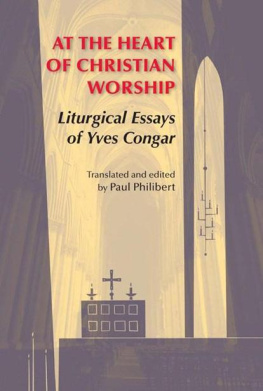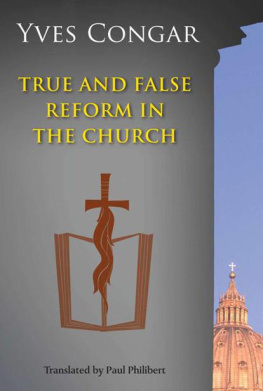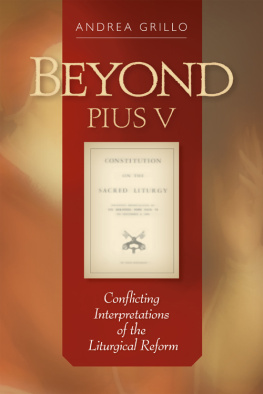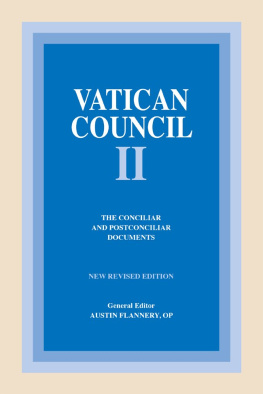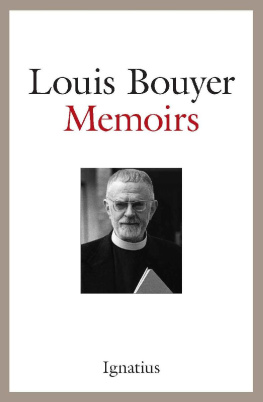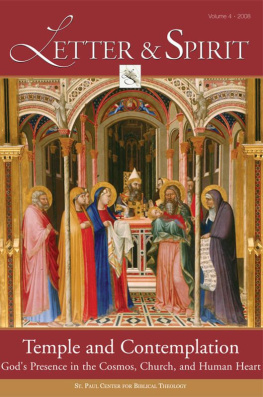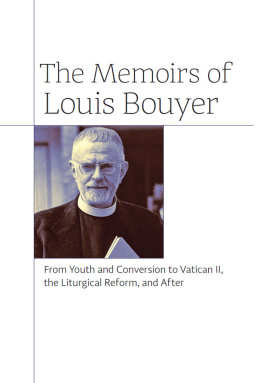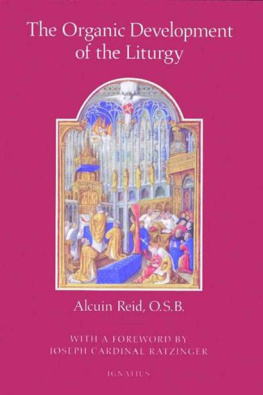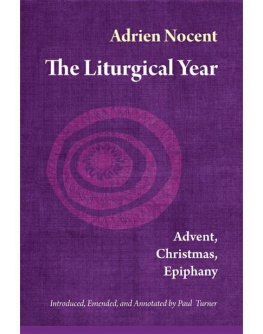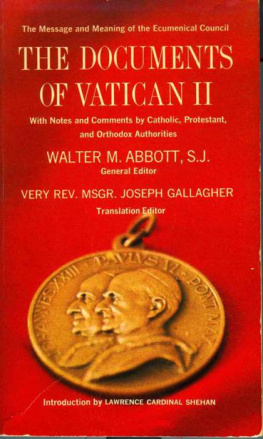The essays translated here are a treasure trove of theological reflection linking liturgy to ecclesiology. They are as fresh today as they were when Congar first wrote them. We are in Paul Philiberts debt.
John F. Baldovin, SJ Professor of Historical and Liturgical Theology Boston College School of Theology and Ministry
What a gift to the Church by translator and editor, Paul Philibert, as he makes these essays of Yves Congar available in English! The essays gathered here, although written decades ago, are totally applicable today as the Church continues to grapple with a key principle of the Second Vatican Councils teaching that the whole local community of faith is the subject or agent of worship. Philibert gives us both accurate and readable translations of Congars French while also providing us with sound hermeneutical principles of interpretation in his brilliant Introduction and Conclusion sections. We owe him a great debt of thanks!
Gerard Austin, OP Rice School for Pastoral Ministry Arcadia, Florida
These essays combine immense erudition with arguments that are accessible to the non-specialist. They offer a rare combination of passion and precision, and they are at least as relevant today as when they were first published.
Timothy Radcliffe, OP Author of What Is the Point of Being a Christian? and Why Go to Church?: The Drama of the Eucharist
Congar may have written these chapters decades ago (even before the Council), but they read like they were written for us today. They are relevant, timely, and challenging for us now because they call us to be church, to exercise our common priesthood, to live what we celebrate.
Joyce Ann Zimmerman, CPPS, PhD, STD Director of the Institute for Liturgical Ministry Dayton, Ohio
AT THE HEART
OF CHRISTIAN WORSHIP Liturgical Essays of Yves Congar
Translated and edited
by Paul Philibert
A PUEBLO BOOK Liturgical Press Collegeville, Minnesota
www.litpress.org
A Pueblo Book published by Liturgical Press Cover design by David Manahan, O.S.B. Illustration by Frank Kacmarcik, Obl.S.B. Photo courtesy of photos.com. This volume is a collection of essays first published in French: LEcclesia ou communaut chrtienne, sujet intgral de laction liturgique , collection Unam Sanctam , n 66; Structure et sacerdoce chrtien , collection Unam Sanctam , n 41; Situation du sacr en rgime chrtien , collection Unam Sanctam , n 66; Pour une liturgie et une prdication relles , in La Maison Dieu , n 16; Prsentation simple de lide essentielle du Dimanche , in La Maison Dieu , n 13. Les ditions du Cerf. Excerpts from the English translation of the Catechism of the Catholic Church for use in the United States of America copyright 1994, United States Catholic Conference, Inc.Libreria Editrice Vaticana. English translation of the Catechism of the Catholic Church: Modifications from the Editio Typica copyright 1997, United States Catholic Conference, Inc.Libreria Editrice Vaticana. Used with Permission. 2010 by Order of Saint Benedict, Collegeville, Minnesota. All rights reserved. No part of this book may be reproduced in any form, by print, microfilm, microfiche, mechanical recording, photocopying, translation, or by any other means, known or yet unknown, for any purpose except brief quotations in reviews, without the previous written permission of Liturgical Press, Saint Johns Abbey, PO Box 7500, Collegeville, Minnesota 56321-7500. Printed in the United States of America. Library of Congress Cataloging-in-Publication Data Congar, Yves, 1904-1995.
[Selections. English. 2010]
At the heart of Christian worship : liturgical essays of Yves Congar;
translated and edited by Paul Philibert.
p. cm.
A Pueblo book.
Includes index.
ISBN 978-0-8146-6229-8 ISBN 978-0-8146-6235-9 (e-book)
1. Liturgics. 2. Catholic ChurchLiturgy. I. Philibert, Paul J. II. Title.
BX1970.C668 2010
264.02dc22 2009053884
Contents
Introduction
The title of this book, At the Heart of Christian Worship , refers above all to the corporate life of the Christian faithful, who offer their lives to God as a living sacrifice at the same time as they bind themselves more deeply to their Lord and Savior. This movement of self-offering and identification with Christ is precisely what is at the heart of worship, as expressed both in ritual acts and in the daily living of the Christian faith. Summarizing the theological developments of the Second Vatican Council with reference to the participation of the faithful in the Eucharist, the Catechism of the Catholic Church explains:
The Eucharist is also the sacrifice of the Church . The Church which is the Body of Christ participates in the offering of her Head. With him, she herself is offered whole and entire. She unites herself to his intercession with the Father for all men. In the Eucharist the sacrifice of Christ becomes also the sacrifice of the members of his Body. The lives of the faithful, their praise, sufferings, prayer, and work, are united with those of Christ and with his total offering, and so acquire a new value. Christs sacrifice present on the altar makes it possible for all generations of Christians to be united with his offering. (CCC 1368)
This summary paragraph reflects in capsule form the fundamental argument of the essays in this book as well as the penetrating theological intuition that lies behind it. In the age of the church, as Yves Congar puts it, the risen Christ can never be thought of apart from his body; the head cannot be thought of apart from the members.
Like the Fathers of the Church centuries ago, Yves Congar appreciated the twofold consequence of this revealed truth. First, as baptized faithful, our real, our most authentic life is a life shrouded in mystery, yet nonetheless it affects and conditions the entirety of our human experience. To live in Christ, as St. Paul so often puts it, means to replicate in our spontaneous daily experience the patience of Christ in the face of undeserved suffering, on the one hand, and his confidence in the will and the power of his divine Father, on the other hand. His paschal journey of suffering, death, and resurrection is an anthropological paradigm, a pattern for authentic living that both explains the point of life and offers the faithful the grace of moving from dying to rising.
Second, the solidarity of the Christian faithful with their divine head already draws them into the divine Sons singular relation with his Father. If the risen Christ is the unique priest of the new covenant, then the members of his body share in that priesthood. If the risen Christ presents as his priestly sacrifice the one perfect gift of his own self-offering, then the members of his body have the vocation to make this same self-oblation of themselves.
The biblical and conciliar theme of the People of God is, at root, the expression of this mystery which fulfills all the promises of the old covenant and inaugurates a new age, a new covenant of grace. The vocation of all those rooted in Christ by baptism and by the anointing of the Holy Spirit is to become a great, living sacramenta holy sign that achieves what it signifies. They are meant to become the presence of God inserted into the midst of human life and culture by means of their graced actions as members of Christs body.
In Congars writings, as in the councils dogmatic constitution Lumen Gentium (On the Church), the link between the theology of the People of God and the mystery of the Mystical Body is inseparable. As we shall see in the pages that follow, for Congar, this theme about the People of God could never imaginably be considered a claim to some sort of secularized social autonomy. It is precisely the expression of a spiritual rootedness so profound that its influence finds expression in the totality of the relationships and activities of the faithful.
I remember some forty years ago discussing with Father Congar the theme of incarnation and its pastoral expression in the years immediately after the council. As an inexperienced graduate student, I was suggesting that the church needed to stress incarnationalism as opposed to eschatology, so as to draw the faithful into a deeper involvement with their religious life. Congar became quite animated, insisting that Catholic theology can never lose its balance between the incarnational and the eschatologicalthat in sacramental and pastoral terms, incarnation means making visible, accessible, and palpable a mystery that is itself fully eschatological. Put more simply, in attending to the concerns of communicating with the present day, we can never lose focus on the mystery of Christs heavenly priesthood. Contemporary human involvement in the liturgy and pastoral service must find its source and its energy in divine gifts bestowed by the Holy Spirit.
Next page
